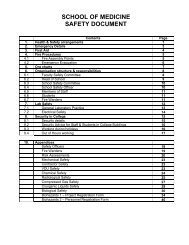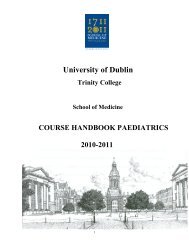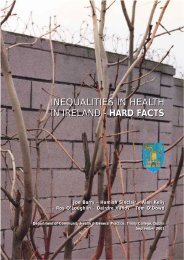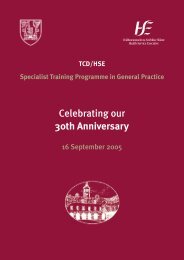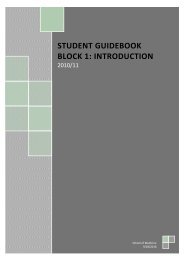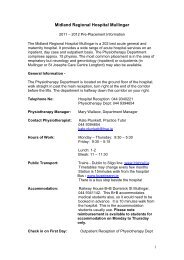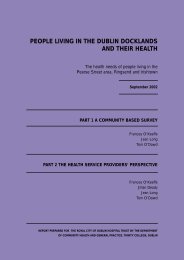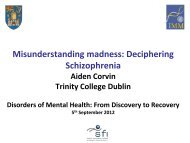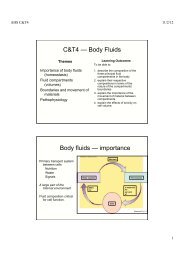people living in finglas and their health - School of Medicine - Trinity ...
people living in finglas and their health - School of Medicine - Trinity ...
people living in finglas and their health - School of Medicine - Trinity ...
You also want an ePaper? Increase the reach of your titles
YUMPU automatically turns print PDFs into web optimized ePapers that Google loves.
DISCUSSION - PART 1<br />
The high response rate <strong>in</strong>dicates a high level <strong>of</strong> <strong>in</strong>terest <strong>in</strong> <strong>health</strong> <strong>in</strong> the F<strong>in</strong>glas area. The researchers noted that<br />
the respondents were very will<strong>in</strong>g to participate <strong>in</strong> the survey <strong>and</strong> were keen to <strong>of</strong>fer <strong>their</strong> op<strong>in</strong>ions about the<br />
<strong>health</strong> services <strong>and</strong> the <strong>health</strong> service needs <strong>in</strong> the area. There were similar response rates <strong>in</strong> the areas<br />
classified as high deprivation <strong>and</strong> low deprivation.<br />
F<strong>in</strong>glas has a larger proportion <strong>of</strong> <strong>in</strong>dividuals aged 65 years <strong>and</strong> older than the proportion <strong>liv<strong>in</strong>g</strong> <strong>in</strong> the total<br />
Eastern Regional Health Authority area (16% versus 10%). 9 The higher proportion <strong>of</strong> older <strong>people</strong> is also<br />
reflected <strong>in</strong> the proportion <strong>of</strong> the population request<strong>in</strong>g services for the elderly, with 36% <strong>of</strong> the primary carers<br />
request<strong>in</strong>g community services <strong>and</strong>/or additional <strong>in</strong>stitutional services for older <strong>people</strong>. When the suggested<br />
additional services for the elderly were further analysed, it was clear that older <strong>people</strong> (<strong>and</strong> <strong>in</strong>deed <strong>their</strong> carers)<br />
wanted to be supported to live <strong>in</strong> <strong>their</strong> own homes for as long as possible.<br />
The population <strong>liv<strong>in</strong>g</strong> <strong>in</strong> F<strong>in</strong>glas is less mobile than the populations <strong>liv<strong>in</strong>g</strong> <strong>in</strong> either Tallaght or the Dockl<strong>and</strong>s. 3 6<br />
For example, 25% <strong>of</strong> the population <strong>in</strong> F<strong>in</strong>glas moved <strong>in</strong>to the area <strong>in</strong> the last ten years compared to 33% who<br />
moved <strong>in</strong>to Tallaght <strong>and</strong> 50% who moved <strong>in</strong>to the Dockl<strong>and</strong>s <strong>in</strong> the same time period.<br />
Outright home ownership is higher <strong>in</strong> F<strong>in</strong>glas (44%) than <strong>in</strong> either Tallaght (21%) or the Dockl<strong>and</strong>s (25%)<br />
<strong>in</strong>dicat<strong>in</strong>g a relatively stable (long term) population. 3 6 Forty-six percent (62/142) <strong>of</strong> the primary carers aged 65<br />
years <strong>and</strong> over owned <strong>their</strong> own home <strong>and</strong> although this is desirable for older <strong>people</strong>, it has implications <strong>in</strong> terms<br />
<strong>of</strong> upkeep, repairs <strong>and</strong> ma<strong>in</strong>tenance. Several older respondents mentioned that <strong>their</strong> sons or daughters, who<br />
wanted to live <strong>in</strong> the F<strong>in</strong>glas area, were unable to buy or rent a house <strong>in</strong> the locality due either to cost or<br />
availability. This reduces the ease with which younger (or middle aged) family members could possibly support<br />
<strong>their</strong> older relatives, which results <strong>in</strong> older <strong>people</strong> feel<strong>in</strong>g isolated, reduces opportunity for family support <strong>in</strong> the<br />
home environment <strong>and</strong> <strong>in</strong>deed has implications for the work loads <strong>of</strong> <strong>health</strong> service providers <strong>in</strong> F<strong>in</strong>glas.<br />
At all stages <strong>of</strong> this <strong>in</strong>vestigation, <strong>people</strong> mentioned that personal security was a major problem <strong>in</strong> the area,<br />
particularly for older <strong>people</strong>. The recent RAPID report describes the various types <strong>of</strong> crime (burglary <strong>and</strong> anti-social<br />
behaviour) commonly perpetrated by <strong>in</strong>dividuals <strong>in</strong> the F<strong>in</strong>glas area <strong>and</strong> this supports the fears <strong>of</strong> <strong>in</strong>timidation or<br />
<strong>in</strong>jury expressed by community members participat<strong>in</strong>g <strong>in</strong> this survey, <strong>in</strong> particular the elderly. 10 It is important to note<br />
that the proportion <strong>of</strong> primary carers (12%) report<strong>in</strong>g experience <strong>of</strong> violence or <strong>in</strong>timidation <strong>in</strong> the year prior to the<br />
survey was similar to proportions <strong>in</strong> both Tallaght (10%) <strong>and</strong> the Dockl<strong>and</strong>s (11%) which implies violence is a<br />
problem <strong>in</strong> urban areas <strong>of</strong> Dubl<strong>in</strong>. 3 6 In all three surveys a high proportion <strong>of</strong> respondents sought medical care<br />
(F<strong>in</strong>glas 32%, Tallaght 23% <strong>and</strong> the Dockl<strong>and</strong>s 33%) follow<strong>in</strong>g a violent <strong>in</strong>cident. This highlights two factors, first<br />
that the violence experienced resulted <strong>in</strong> <strong>in</strong>jury <strong>and</strong> secondly that violence is a <strong>health</strong> care issue.<br />
A higher proportion (30%) <strong>of</strong> <strong>people</strong> <strong>liv<strong>in</strong>g</strong> <strong>in</strong> F<strong>in</strong>glas had a chronic illness than the proportions <strong>in</strong> either Tallaght<br />
(22%) or the Dockl<strong>and</strong>s (27%). 3 6 Respondents reported higher utilisation <strong>of</strong> general practitioner services <strong>in</strong><br />
F<strong>in</strong>glas (58%) than the proportions reported <strong>in</strong> Tallaght (38%) or the Dockl<strong>and</strong>s (47%), which <strong>in</strong>dicates a high<br />
level <strong>of</strong> dependency on community based services. The high proportion <strong>of</strong> older <strong>people</strong> <strong>liv<strong>in</strong>g</strong> <strong>in</strong> F<strong>in</strong>glas, <strong>and</strong> <strong>of</strong><br />
these, the high proportion with a chronic illness (66%) may partly expla<strong>in</strong> this excess utilisation.<br />
The proportion <strong>of</strong> respondents (39%) with private <strong>health</strong> <strong>in</strong>surance <strong>in</strong> F<strong>in</strong>glas is lower than the proportion (45%)<br />
for the Irish population as a whole. 11 For those less than seventy years old, the medical card is a good <strong>in</strong>dicator<br />
<strong>of</strong> economic status as it is means tested. The proportion (35%) <strong>of</strong> the population <strong>in</strong> F<strong>in</strong>glas with a medical card<br />
is similar to the national coverage rate (32%), 11 but higher than the average for the Eastern Regional Health<br />
Authority area (26%),9 <strong>in</strong>dicat<strong>in</strong>g that poverty is concentrated <strong>in</strong> specific geographical areas <strong>of</strong> this region. One<br />
quarter <strong>of</strong> the households <strong>in</strong> F<strong>in</strong>glas have neither private <strong>health</strong> <strong>in</strong>surance nor a medical card <strong>in</strong>dicat<strong>in</strong>g a<br />
sizeable m<strong>in</strong>ority dependant on <strong>their</strong> own resources for primary <strong>health</strong> care. Of note, the proportion (26%)<br />
without either private <strong>health</strong> <strong>in</strong>surance or a medical card was higher <strong>in</strong> the F<strong>in</strong>glas area than <strong>in</strong> the Dockl<strong>and</strong>s<br />
(12.5%) <strong>and</strong> lower than <strong>in</strong> Tallaght (37.5%) 3 6.<br />
Interest<strong>in</strong>gly, <strong>in</strong> both F<strong>in</strong>glas <strong>and</strong> Tallaght a considerable proportion had availed <strong>of</strong> adult education opportunities<br />
(9% <strong>and</strong> 15% respectively). 3 However, similar high proportions <strong>of</strong> primary carers <strong>liv<strong>in</strong>g</strong> <strong>in</strong> both F<strong>in</strong>glas (40%)<br />
<strong>and</strong> Tallaght (36%) reported that they had not completed primary education though these are lower than the<br />
proportion <strong>of</strong> respondents who had not completed primary education <strong>liv<strong>in</strong>g</strong> <strong>in</strong> the Dockl<strong>and</strong>s (50%). 3 6 The level<br />
<strong>of</strong> educational atta<strong>in</strong>ment for <strong>people</strong> <strong>liv<strong>in</strong>g</strong> <strong>in</strong> F<strong>in</strong>glas has implications <strong>in</strong> terms <strong>of</strong> written communications,<br />
development <strong>of</strong> <strong>health</strong> education materials <strong>and</strong> <strong>in</strong>deed cl<strong>in</strong>ical consultations.<br />
In both F<strong>in</strong>glas (49%) <strong>and</strong> the Dockl<strong>and</strong>s (49%), similar proportions <strong>of</strong> households had at least one person who<br />
smoked cigarettes. 6 Although lower than Tallaght (69%), this <strong>in</strong>dicates considerable levels <strong>of</strong> passive smok<strong>in</strong>g. 3<br />
Among household members 18 years old or over, 28% smoked, which is just below the national figure for<br />
cigarette smok<strong>in</strong>g (28% versus 31%). 12<br />
The proportions report<strong>in</strong>g alcohol or drug misuse across all three surveys (Tallaght 2%, the Dockl<strong>and</strong>s 1% <strong>and</strong><br />
F<strong>in</strong>glas 1%) are lower than expected. 3 6 We are <strong>of</strong> the op<strong>in</strong>ion that alcohol <strong>and</strong> drug related problems were<br />
under reported to our researchers by respondents <strong>in</strong> F<strong>in</strong>glas, as <strong>health</strong> <strong>and</strong> social issues relat<strong>in</strong>g to substance<br />
misuse were frequently raised by primary carers. Also, two <strong>of</strong> the <strong>in</strong>dividuals for whom a cause <strong>of</strong> death was<br />
provided <strong>in</strong>dicated that the two deaths were related to drug or alcohol misuse. Furthermore, several <strong>of</strong> the<br />
primary carers requested extended alcohol <strong>and</strong> drug services <strong>and</strong> two primary carers specifically discussed the<br />
need for services for <strong>people</strong> who have become homeless as a result <strong>of</strong> <strong>their</strong> substance misuse.<br />
Stress has been identified as a factor, which can negatively affect one’s sense <strong>of</strong> physical or mental well be<strong>in</strong>g. 13<br />
Almost two thirds <strong>of</strong> primary carers (63%) reported experienc<strong>in</strong>g stress <strong>in</strong> the year prior to the survey. This was<br />
similar to levels reported <strong>in</strong> the Tallaght (59%) <strong>and</strong> the Dockl<strong>and</strong>s (53%) surveys. 3 6 In F<strong>in</strong>glas the majority<br />
acknowledged experienc<strong>in</strong>g negative consequences <strong>of</strong> stress such as, anxiety, <strong>in</strong>somnia <strong>and</strong> depression. These<br />
symptoms can have a negative impact on an <strong>in</strong>dividual’s general <strong>health</strong>.<br />
In all three surveys the primary carers cited family related issues as the ma<strong>in</strong> source <strong>of</strong> stress. As <strong>in</strong> the two<br />
previous surveys, 3 6 the majority (67%) sought help from family or friends to relieve the stress <strong>and</strong> 40% sought<br />
help from <strong>their</strong> general practitioner. Interest<strong>in</strong>gly, more <strong>in</strong>dividuals (16%) sourced alternative medical treatments<br />
to relieve stress <strong>in</strong> F<strong>in</strong>glas than <strong>in</strong> either Tallaght (10%) or the Dockl<strong>and</strong>s (3%). However, as <strong>in</strong> the previous<br />
surveys there is little other evidence <strong>of</strong> community based non-pharmacological support for stress. This highlights<br />
the need for <strong>health</strong> service providers to provide <strong>and</strong> promote alternative methods <strong>of</strong> stress management.<br />
The teenage population <strong>in</strong> F<strong>in</strong>glas is large <strong>and</strong> is a major source <strong>of</strong> stress for parents, the majority <strong>of</strong> whom are<br />
concerned about physical violence <strong>and</strong> substance misuse problems. Accord<strong>in</strong>g to anecdotal evidence there has<br />
been a number <strong>of</strong> tragic deaths among young males <strong>in</strong> the F<strong>in</strong>glas area. The impact <strong>of</strong> these deaths on the<br />
young <strong>people</strong> <strong>liv<strong>in</strong>g</strong> <strong>in</strong> the area is a source <strong>of</strong> concern for all community members <strong>in</strong> particular the parents <strong>of</strong><br />
teenagers. Psychological <strong>and</strong> counsell<strong>in</strong>g support services for young <strong>people</strong> were identified as additional<br />
services required todeal with these issues <strong>in</strong> the area. The apparent high rate <strong>of</strong> young male deaths has already<br />
been identified by the Northern Area Health Board to be a concern <strong>and</strong> a report has been commissioned which<br />
is due to be published shortly.<br />
Primary carers who were parents <strong>of</strong> children aged between two <strong>and</strong> five years were asked about <strong>their</strong> children’s<br />
immunisations. Although numbers are small, vacc<strong>in</strong>e uptake rates <strong>in</strong> F<strong>in</strong>glas were reported to be higher than<br />
those quoted by the National Disease Surveillance Centre from the Regional Interactive Child Health System<br />
(84% versus 70%). 14 The respondents <strong>in</strong> Tallaght (82%) <strong>and</strong> the Dockl<strong>and</strong>s (96%) also reported higher<br />
vacc<strong>in</strong>ation completion rates. 3 6 DISCUSSION - PART 1<br />
58<br />
59






